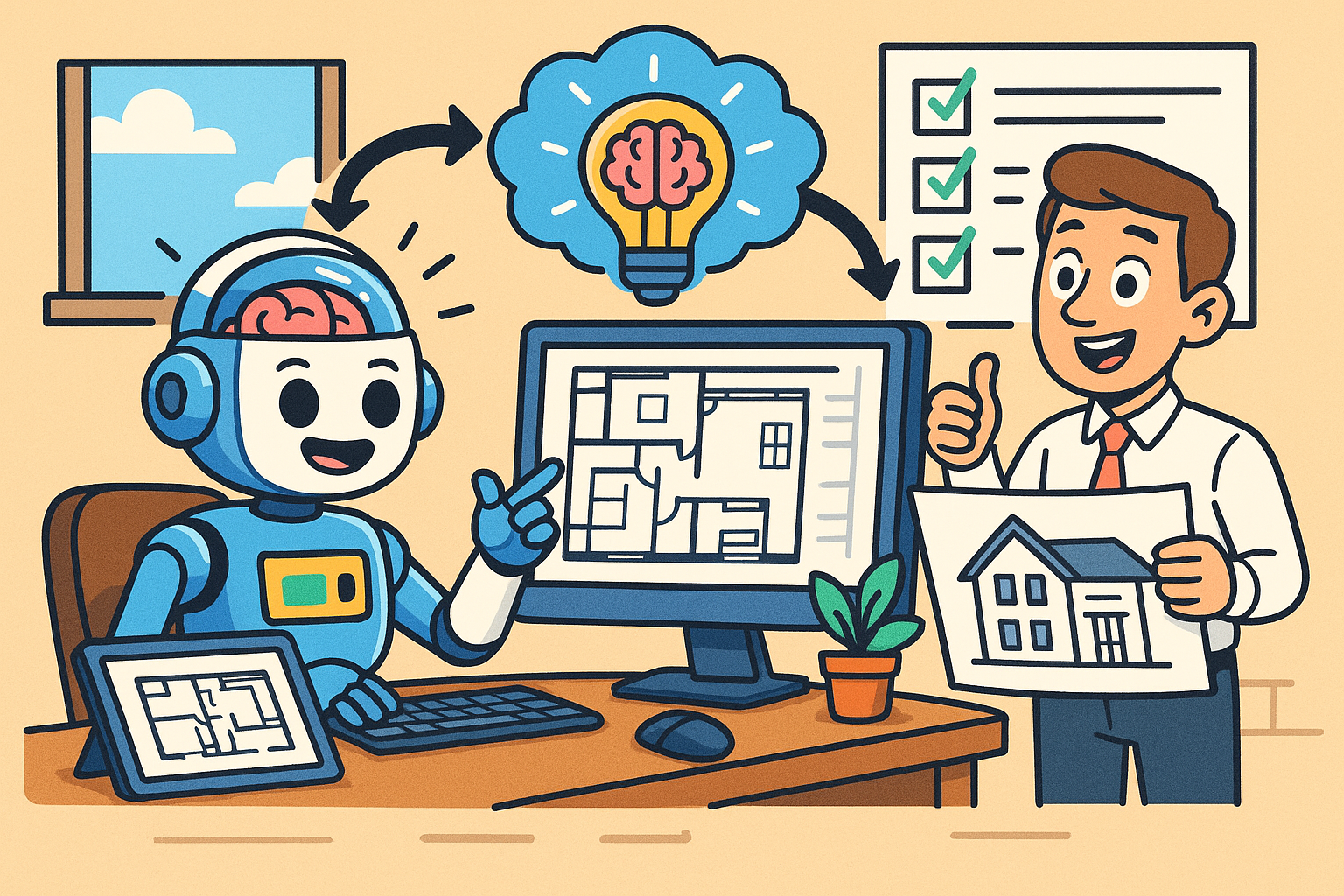Your Cart is Empty
Customer Testimonials
-
"Great customer service. The folks at Novedge were super helpful in navigating a somewhat complicated order including software upgrades and serial numbers in various stages of inactivity. They were friendly and helpful throughout the process.."
Ruben Ruckmark
"Quick & very helpful. We have been using Novedge for years and are very happy with their quick service when we need to make a purchase and excellent support resolving any issues."
Will Woodson
"Scott is the best. He reminds me about subscriptions dates, guides me in the correct direction for updates. He always responds promptly to me. He is literally the reason I continue to work with Novedge and will do so in the future."
Edward Mchugh
"Calvin Lok is “the man”. After my purchase of Sketchup 2021, he called me and provided step-by-step instructions to ease me through difficulties I was having with the setup of my new software."
Mike Borzage
Harnessing AI for Automated Design Review: Transforming Modern Workflows
June 10, 2025 9 min read


Setting the Context
The evolution of design processes in recent years has paved the way for innovative approaches that challenge the traditional methods of reviewing design output. In this emerging landscape, automated design review has sparked considerable interest among industry professionals, as it meets the growing need for rapid, accurate, and consistent feedback in modern design workflows. Over time, the pace of product development has increased dramatically, which in turn requires faster iterations and seamless integration of new technologies into existing processes. In particular, the integration of advanced analytical tools to interpret vast data sets allows designers to not only detect errors earlier but also harness evolving trends in aesthetics, compliance, and functionality. This transformation is further amplified by the introduction of artificial intelligence into standard workflow procedures, where it manages to extract key patterns and insights that augment human capabilities.
Defining Automated Design Review
At its core, automated design review refers to the application of computer-based systems to assess design outputs by leveraging sophisticated algorithms and computational analysis. As design projects become more intricate and data-rich, traditional review methodologies—often reliant on manual checks and subjective evaluations—prove insufficient. The rapid feedback loop enabled by automated systems ensures that errors, inconsistencies, and potential deviations from the required standards are identified early in the design process. This capability not only enhances the overall quality of the final product but also reduces rework and shortens project timelines significantly. Designers are thus able to make informed decisions in real time, which is critical for maintaining the pace demanded by modern competitive markets. With increasing reliance on digital platforms and cloud-based collaboration, the movement towards automated design review is becoming a key strategic advantage for companies looking to streamline operations while enhancing creative output.
Integration of Artificial Intelligence
The infusion of artificial intelligence into design review systems has brought forth a transformative approach that is redefining the boundaries of what can be accomplished in the field. AI-driven methodologies rely on a confluence of machine learning algorithms, natural language processing, and advanced computer vision techniques to interpret complex datasets that range from detailed engineering drawings to descriptive design documentation. When combined, these technologies unlock the potential to not only automate routine verification tasks but also to anticipate and mitigate emerging issues before they become problematic. Moreover, such systems are capable of evolving over time, learning from new design inputs to refine their analysis, ultimately offering designers intelligent, contextual suggestions that are tailored to the specific nuances of each project. This reinforcement of knowledge through iterative learning establishes a robust framework for continuous improvement, which is essential in an industry where innovation and precision are paramount.
Traditional versus AI-Driven Methodologies
In contrast to the conventional methods that have long dominated design reviews, the AI-driven approach introduces several critical enhancements that reshape how designers interact with their tools. Traditional review processes are inherently static and often involve time-consuming manual inspections, which not only escalate the possibility of human error but also limit the scope of review to areas that are explicitly programmed into the system. On the other hand, AI-based solutions offer a dynamic, self-improving mechanism where feedback is generated in real time, allowing for the prompt identification of discrepancies and the recommendation of corrective measures. Key differences between these approaches include the speed at which feedback can be delivered, the depth of analysis achievable through pattern recognition and anomaly detection, and the potential for continuous adaptation based on new data. Designers now benefit from a more holistic view of their projects, where both quantitative measurements and qualitative assessments merge seamlessly to foster more innovative and efficient design outcomes.
AI Technologies and Techniques in Design Review
The cornerstone of AI-powered design review is an array of advanced technologies that function synergistically to automate what was once an intricate manual process. Among these, machine learning algorithms play a pivotal role by enabling systems to identify complex patterns and diagnose anomalies within design data. These algorithms can be trained on large datasets to understand not only the typical attributes of effective designs but also the subtle nuances that might indicate a flaw or a potential risk. In addition, the capacity for these algorithms to learn and adapt over time transforms the overall system into one that improves continuously, refining its judgment with every interaction. By incorporating natural language processing, these systems transcend mere numerical and visual data analysis; they gain the ability to process textual elements found in design documents, technical notes, and specification sheets. Such an expansive view is crucial in environments where design requirements and annotations often carry significant weight in determining the final output.
Core AI Components Driving the Review Process
The integration of multiple AI components underpins the efficiency and accuracy of automated design review systems. The primary components include:
- Machine Learning Algorithms: These are employed for pattern recognition and anomaly detection, ensuring that any deviations from standard design practices are swiftly flagged for review.
- Natural Language Processing: This technology enables the system to interpret complex design documentation, extracting actionable insights from detailed instructions and developer notes.
- Computer Vision Techniques: By analyzing design schematics and CAD drawings, computer vision systems can visually interpret intricate details that might otherwise be overlooked in textual analysis.
Combining AI Techniques for Comprehensive Analysis
The synergy of artificial intelligence techniques in design review marks a turning point for modern design practices. By incorporating computer vision, machine learning, and natural language processing under one umbrella, designers obtain a multi-faceted tool that delivers insights across various domains of the design process. Such a system handles multiple tasks simultaneously: from verifying geometric consistency in schematics to interpreting the contextual relevance of descriptive annotations. This integration allows the system to intricately understand and evaluate design elements, resulting in a more robust analysis framework that minimizes oversight while maximizing constructive feedback. Moreover, the continuous learning aspect ensures that as new design trends and challenges emerge, the system dynamically adjusts its analytical models, delivering a level of flexibility previously unattainable through conventional means. The result is a feedback loop that not only identifies errors but also suggests potential design optimizations, fostering rapid innovation and significantly reducing turnaround time.
Benefits, Challenges, and Emerging Trends
The integration of AI within design review frameworks presents an array of benefits that transform the landscape of design workflows while also introducing complexities that merit careful consideration. One of the most compelling advantages is the marked increase in efficiency, as AI-driven systems provide instantaneous, reliable assessments that reduce the time spent on manual review processes. This acceleration leads to significantly shorter ideation and iteration cycles, which is essential in fast-paced, competitive industries. Furthermore, by minimizing the margin for human error, these systems ensure that design outputs meet both aesthetic and functional benchmarks, thereby bolstering overall quality. In addition, the integration of AI opens the door to data-driven decision-making, where continuous insights allow for proactive adjustments and sustained improvements over the lifecycle of a project.
Benefits of AI Integration in Design Review
The advantages offered by AI in automated design review are multifaceted and can be summarized in several key areas:
- Increased Efficiency: Automation drastically reduces review times, enabling designers to focus on creative problem solving rather than routine error-checking.
- Reduced Human Error: By minimizing dependency on manual reviews, the system ensures a consistent level of quality and accuracy in design outcomes.
- Streamlined Workflows: The ability to provide instant, actionable feedback facilitates quick iterations, thereby improving the overall design cycle.
- Data-Driven Insights: Continuous monitoring and analysis yield valuable metrics, driving enhancements in design quality and fostering a proactive approach to problem-solving.
Challenges in Adopting AI Technologies
Despite the significant advantages, the adoption of AI in design reviews must navigate a set of challenges that can impede seamless integration. One of the primary obstacles is the issue of compatibility; many existing design tools and legacy systems operate on frameworks that require substantial adaptation before they can interface effectively with AI-driven platforms. Another challenge is striking the delicate balance between automation and human creativity. While AI excels when it comes to systematic, data-driven analysis, it has limitations in capturing nuanced aesthetic judgments or innovative design approaches that require human ingenuity. Additionally, maintaining the security of sensitive design data is of paramount importance, as increased reliance on digital systems inherently raises concerns regarding data breaches and intellectual property protection. Therefore, developing a robust governance framework that ensures data integrity and transparency in AI decision-making is crucial for widespread acceptance and effective implementation.
Emerging Trends and Future Directions
Looking to the future, several emerging trends are poised to further extend the capabilities of AI in the domain of design review. One noteworthy development is the advent of more intuitive feedback systems that integrate seamlessly into existing design environments. These systems are set to leverage advanced simulation tools and augmented reality platforms, thereby providing a more holistic view of design projects. In addition, the evolution of predictive and prescriptive design analytics is expected to shift the focus from merely flagging issues to actively guiding the design process. The prospect of AI systems that not only recognize anomalies but also predict potential problems before they occur represents a significant leap forward in design automation. Moreover, as AI continues to mature, the convergence of these advanced techniques will likely prompt a redefinition of the creative process itself—balancing data analytics with human artistry. Designers will find themselves empowered with tools that enhance their capabilities rather than replace the invaluable insights that come from human expertise, thereby ensuring that innovation remains at the core of design disciplines.
Conclusion
The transformative role of AI in automating design reviews has provided the design, engineering, and architectural domains with unprecedented capabilities. This technology not only enhances review speed but also improves design accuracy by leveraging real-time, intelligent feedback mechanisms that support continuous improvement. As design projects grow in complexity and scale, the need for systems that can process diverse data streams and deliver comprehensive analysis is more pertinent than ever. AI has enabled a shift from traditional, labor-intensive review processes towards dynamic, data-centric models that foster stronger communication between design intent and final execution. In this evolving landscape, the integration of AI emerges as a game changer, fundamentally altering how design reviews are conducted and paving the way for innovations that were previously unimaginable.
Recap of AI's Transformative Role in Design Review
Summarizing the core insights from our discussion, it is evident that the automated design review process powered by AI is reshaping modern design workflows in several significant ways. First, it offers unparalleled efficiency by reducing the time required for error detection and iterative feedback. Second, by learning from historical data, the AI systems continuously refine their analysis, making them more effective in identifying underlying issues that might elude conventional methods. Third, the adoption of components such as machine learning, natural language processing, and computer vision facilitates a deeper understanding of both the technical and contextual nuances of design projects. This, in turn, inspires confidence in the feedback provided, ensuring that the overall design output maintains high standards of quality and innovation. The move towards AI-driven reviews thereby confirms that the future of design must embrace not just automated processes but also the intelligent guidance offered by these advanced systems.
Balancing Technology with Human Expertise
While the benefits of AI are compelling, it is crucial to interpret these advancements as complementary to human expertise rather than as a replacement. The intricate balance between automated processes and human judgment represents a key challenge for organizations as they integrate these technologies into their workflows. Designers are tasked with navigating a landscape where algorithmic insights and creative problem-solving coexist to produce superior outcomes. By recognizing the unique strengths that both humans and AI bring to the table, organizations can create more resilient, innovative, and adaptive systems. Furthermore, ensuring transparency and maintaining a clear governance framework around AI decision-making processes serves as a critical measure in securing stakeholder confidence and achieving meaningful collaboration between technology and human intuition. Ultimately, the pathway to innovation lies in harnessing the best aspects of both realms.
Forward Looking Perspective on AI and Design Software
Looking ahead, the continued evolution of AI holds immense potential for the future of design software, pushing the boundaries of what is possible in both engineering and architectural domains. Emerging trends such as the integration of augmented reality tools, enhanced simulation capabilities, and predictive analytics promise to further refine the design review process. As AI systems grow in sophistication, they are expected to provide even deeper insights into design parameters, advising on not only error correction but also proactive design enhancements. This forward-looking approach creates a robust framework for innovation, where continuous feedback loops and data-driven decision-making will become ingrained in every stage of the design cycle. The confluence of these advanced technologies heralds a future where design reviews are not viewed as a final checkpoint, but as an integral aspect of the iterative design process, continuously driving performance and inspiring creativity. Stakeholders who embrace these platforms will find themselves well-positioned to lead their industries through increasingly competitive and technologically dynamic environments.
Also in Design News

Cinema 4D Tip: Lock Framing Early with Cinema 4D Safe Frames and Aspect Overlays
October 30, 2025 2 min read
Read More
ZBrush Tip: Conservative Projection Workflow for Artifact-Free Detail Transfer
October 30, 2025 2 min read
Read More
V-Ray Tip: Bake Static GI into Lightmaps for Real-Time Engines
October 30, 2025 2 min read
Read MoreSubscribe
Sign up to get the latest on sales, new releases and more …


